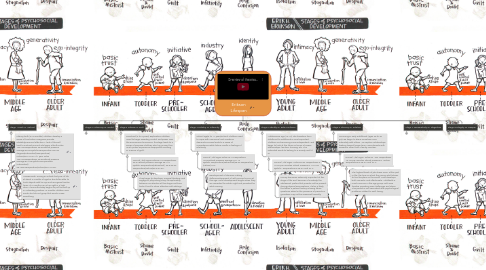
1. Stage 1 Trust vs. Mistrust
1.1. Infancy birth (0-18 months) Children develop a sense of trust when caregivers provide reliability,care,and affection.A lack of this will lead to mistrust.Normal vital signs at birth.Pulse 100-180.Respirations 30-60,Blood pressure average 60-90 systolic,Temperature 98-100 degrees(Fahrenheit),Temperature( Celcius)36.7-37.8.At 1 year Pulse 100-160,Respirations 30-60,Blood pressure average 87-105 systolic,Temperature (Fahrenheit) 98-100F.Temperature(celcius)36.7-37.8C.
1.1.1. Assessments. During an infants first year of life at about 2 months of age,he should be able to track objects with his eys and recognize familiar faces.At 6 months can sit up right in a high chair.At 9months baby begins to pull himself up in a standing position.10 months children uses word's but do not grasp that words 'mean' something.
2. Stage 2 Autonomy vs. Doubt
2.1. Early childhood (2 to 3 years).Toilet training.children need to develop a sense of personal control over physical skills and a sence of independence.Success leads to feeling autonomy,failure results infeeling of shame and doubt.
2.1.1. Normal Vital Signs.Pulse 80-110,Respirations 24-40,Blood pressure average 95-105 systolic Temperature(Fahrenheit)96.8-99.6F.Temperature(celcius)36.0-37.6.
2.2. Assessment. They are physiological capable of being toilet trained at age of 12-15 months. They develope separation anxiety becoming "clingy".They begin to understand cause and effect.
3. Stage 3 Initiave vs. Guilt
3.1. Preschool (3 to 5 years) Exploration.Children need to begin asserting control and power over the environment.Success in ths stage leads to a sense of purpose.Children who try yo exert too much power experience disapproval resulting in a sence of guilt.
3.1.1. Normal Vital Signs.Pulse70-110.Respirations 22-34 Blood pressure average 95-110 systolic.Temperature(Fahrenheit) 96.8-99.6F. Temperature(celcius)36.0-37.6C.
3.1.1.1. They begin to develope' magical thinking"and engage in play acting.They"re exploratory behavior accelerates at this stage.First born finds it hard to share attention with siblings.
4. Stage 4 Industry vs. Inferiority
4.1. School age(6 to 11 years)School.Children need to cope with new social and academic demands.Success leads to a sense of competence,while failure results in feelings of inferiority.
4.1.1. Normal Vital Signs.Pulse 65-110.Rspirations 18-30.Blood pressure average 97-112 systolic.Temperature(Fahrenheit)98.6F.Temperature (celcius) 37C.
4.1.1.1. Development of decision making skills.Developement of self-concept occurs at this age.Moral development begins when they are rewarded for what's right and punished for what's wrong.
5. Stage 5 Identity vs. Role Confusion
5.1. Adolescence age (13-19) The transition from childhood to adulthood is most important. Children are becoming more independent, and begin to look at the future in terms of career, relationships, families, housing, etc. The individual wants to belong to a society and fit in.
5.1.1. Normal Vital Signs. Pulse 60-90. Respirations is 12-26 per minutes. Blood Pressure is 112-128 systolic. Temperature is 98.6 F and 37 C.
5.1.1.1. Privacy becomes extremely important at this stage of life and, because of modesty, the adolescent prefers that parents not be present during physical examinations. it also is likely that when a patient history is being taken, questions asked in the presence of parents or guardians may not be answered honestly.
6. Stage 6 Intimacy vs. Isolation
6.1. Occurring in early adulthood (ages 20 to 39 yrs), we begin to share ourselves more intimately with others. We explore relationships leading toward longer term commitments with someone other than a family member.
6.1.1. Normal Vital Signs. Pulse 60 -100. Respirations 12- 20 per minutes. Blood pressure is 120/80. Temperature is 98.6 F and 37 C.
6.1.1.1. The highest levels of job stress occur at this pint in life, the time in which the young adult strives to find his place in the world. Love develops, both romantic and affectionate. Childbirth is most common in the age group, with new families providing new challenges and stress. This period is not associated with psychological problems related to well- being.
7. Stage 7 Geneerativity vs. Stagnation
7.1. During middle adulthood (ages 40 to 64 yrs), we establish our careers, settle down within a relationship, begin our own families and develop a sense of being a part of the bigger picture.
7.1.1. Normal Vital Signs. Pulse 60-100. Respirations is 12-20. Blood pressure is 120/80. Temperature is 98.6 and 37 C.
7.1.1.1. Adults in this age group are more concerned with the "social clock" and become more task oriented as they see the time for accomplishing their lifetime goals recede.
8. Stage 8 Integrity vs. Despair
8.1. As we grow older (61+ years) and become senior citizens, we tend to slow down our productivity, and explore life as a retired person. It is during this time that we contemplate our accomplishments and are able to develop integrity if we see ourselves as leading a successful life.
8.1.1. Vital Signs: heart rate, respiratory rate, and blood pressure depend on the individual's physical health status. Body temperature still averages 98.6 F and 37 C.
8.1.1.1. One of the major challenges for the older adult is maintaining a sense of self-worth. Senior citizens are commonly seen as "over the hill", less intelligent than younger adults, and certainly less able to care for themselves.
